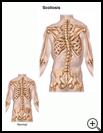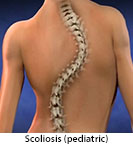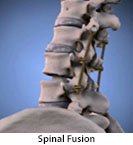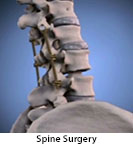
Scoliosis
What is scoliosis?
The spine is made up of bones that normally stack one on top of the other in a straight line. Scoliosis means that the spine curves from side to side rather than running straight down the back. Scoliosis most often affects the bones in the upper back.
Scoliosis develops slowly. It is usually first noticed just before or during puberty when a child goes through a growth spurt. Occasionally, scoliosis is diagnosed during infancy. Females have scoliosis more often than males.
The curvature in your back will never go away, but sometimes it doesn’t cause any symptoms or problems.
What is the cause?
The exact cause of scoliosis is most often not known. It may be caused by:
- Bones in the spine that are not shaped correctly
- Legs that are different lengths
- Rib muscles that pull harder on one part of the spine than another, causing the bones to twist and move out of a straight line
- Diseases such as Ehlers-Danlos syndrome or cerebral palsy
- Injury to the spine
What are the symptoms?
At first, scoliosis does not cause pain and there may not be any clear symptoms. When symptoms do occur, they may include:
- Uneven shoulders, hips, or waist
- A hump on one side of the back
- One or both shoulder blades sticking out
- A slight lean to one side
- Back pain
How is it diagnosed?
Your healthcare provider will ask about your child’s symptoms and medical history and examine your child. X-rays can be taken to measure the curvature.
How is it treated?
Your healthcare provider will suggest treatment based on your child’s age, how much your child is likely to grow, how much the spine curves, and symptoms. Your child may be referred to a back specialist. If your child’s curvature is mild, treatment may be limited to regular checkups every few months to see if the curvature is getting worse. Treatment for more severe curvature may include:
- Back brace and orthosis: Your provider may advise your child to wear a brace and a molded plastic shell called an orthosis. This will not make the spine straighter, but it can help keep the curve from getting worse.
- Physical therapy: Physical therapy helps relieve pain and muscle spasms. It can also help your child learn proper posture and keep a good range of motion.
- Surgery: Your child may need surgery with rods and screws if the curvature is severe. Surgery keeps the curvature from getting worse.
How can I help take care of my child?
Here are some of the things you should encourage your child or teen to do so there is less strain on the back:
- Make sure that your child gets some exercise every day and that it includes stretching and warm-up exercises suggested by your child’s provider or physical therapist. Exercising regularly will not only help your child’s back. It will also help keep your child healthier overall.
- Teach your child to take frequent stretching breaks when sitting at a desk or computer for long periods of time.
- Practice good posture.
- Teach your child to stand with head up, shoulders straight, chest forward, weight balanced evenly on both feet, and pelvis tucked in.
- Whenever your child sits, she should sit in a straight-backed chair and hold her spine against the back of the chair.
- Teach your child to protect her back.
- When moving a heavy object, your child should not face the object and push. It’s better to turn around and use her back to push backwards so the strain is taken by her legs.
- When lifting something heavy, teach your child to bend her knees and hips instead of bending her back. It’s best to avoid lifting heavy objects higher than the waist.
- Your child should carry packages close to the body, with arms bent.
- Your child should avoid carrying bags or backpacks that are too heavy. It’s best to carry a backpack over both shoulders, instead of slung over one shoulder. Bags with long straps that can be carried across the chest may cause less pressure on the back.
- It may help for your child to lie on her side with her knees bent when she sleeps or rests and put a pillow between her knees.
- Help your child lose weight if she is overweight.
Teens diagnosed with scoliosis may feel very self-conscious. If your child is anxious or depressed, seeing a mental health therapist may be helpful.
You can get more information from:
- Scoliosis Research Society
414-289-9107
http://www.srs.org/
Last modified: 2016-05-11
Last reviewed: 2016-05-11




